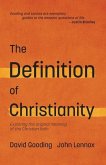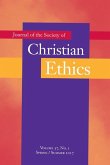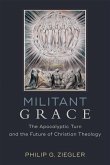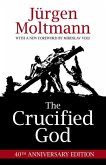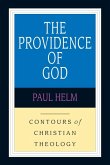Friedrich Schleiermacher
The Christian Faith
Friedrich Schleiermacher
The Christian Faith
- Broschiertes Buch
- Merkliste
- Auf die Merkliste
- Bewerten Bewerten
- Teilen
- Produkt teilen
- Produkterinnerung
- Produkterinnerung
Known as the father of modern theology, Schleiermacher was equally at home in the theological systems of Protestant orthodoxy and the new world of thought shaped by the historical and natural sciences and German philosophy. This ease in different theological frameworks is clearly shown in his discussion of the wide range of themes in dogmatics. This volume outlines Schleiermacher's views on every major doctrine of orthodox Christianity. This classic work in systematic theology remains an indispensable volume to any student of theology, and especially for those who want to understand liberal…mehr
Andere Kunden interessierten sich auch für
![The Definition of Christianity: Exploring the Original Meaning of the Christian Faith The Definition of Christianity: Exploring the Original Meaning of the Christian Faith]() John C. LennoxThe Definition of Christianity: Exploring the Original Meaning of the Christian Faith10,99 €
John C. LennoxThe Definition of Christianity: Exploring the Original Meaning of the Christian Faith10,99 €![Journal of the Society of Christian Ethics: Spring/Summer 2017, Volume 37, No. 1 Journal of the Society of Christian Ethics: Spring/Summer 2017, Volume 37, No. 1]() Journal of the Society of Christian Ethics: Spring/Summer 2017, Volume 37, No. 163,99 €
Journal of the Society of Christian Ethics: Spring/Summer 2017, Volume 37, No. 163,99 €![Christian Faith and the Problem of Evil Christian Faith and the Problem of Evil]() Christian Faith and the Problem of Evil33,99 €
Christian Faith and the Problem of Evil33,99 €![Militant Grace: The Apocalyptic Turn and the Future of Christian Theology Militant Grace: The Apocalyptic Turn and the Future of Christian Theology]() Philip G. ZieglerMilitant Grace: The Apocalyptic Turn and the Future of Christian Theology28,99 €
Philip G. ZieglerMilitant Grace: The Apocalyptic Turn and the Future of Christian Theology28,99 €![Love and You Shall Live Christian Soteriology in the Light of Interreligious Dialogue and the Biblical Notion of Agape Love and You Shall Live Christian Soteriology in the Light of Interreligious Dialogue and the Biblical Notion of Agape]() Leandro FontanaLove and You Shall Live Christian Soteriology in the Light of Interreligious Dialogue and the Biblical Notion of Agape40,99 €
Leandro FontanaLove and You Shall Live Christian Soteriology in the Light of Interreligious Dialogue and the Biblical Notion of Agape40,99 €![The Crucified God The Crucified God]() Jürgen MoltmannThe Crucified God34,99 €
Jürgen MoltmannThe Crucified God34,99 €![The Providence of God The Providence of God]() Paul HelmThe Providence of God29,99 €
Paul HelmThe Providence of God29,99 €-
-
-
Known as the father of modern theology, Schleiermacher was equally at home in the theological systems of Protestant orthodoxy and the new world of thought shaped by the historical and natural sciences and German philosophy. This ease in different theological frameworks is clearly shown in his discussion of the wide range of themes in dogmatics. This volume outlines Schleiermacher's views on every major doctrine of orthodox Christianity. This classic work in systematic theology remains an indispensable volume to any student of theology, and especially for those who want to understand liberal theology. This Cornerstones edition has a new preface written by Professor Paul T. Nimmo, a well-known expert on Schleiermacher and his contribution to theology.
Hinweis: Dieser Artikel kann nur an eine deutsche Lieferadresse ausgeliefert werden.
Hinweis: Dieser Artikel kann nur an eine deutsche Lieferadresse ausgeliefert werden.
Produktdetails
- Produktdetails
- Verlag: Bloomsbury Academic
- 2nd UK edition
- Seitenzahl: 800
- Erscheinungstermin: 25. August 2016
- Englisch
- Abmessung: 235mm x 156mm x 60mm
- Gewicht: 1270g
- ISBN-13: 9780567658845
- ISBN-10: 0567658848
- Artikelnr.: 45102807
- Herstellerkennzeichnung
- Libri GmbH
- Europaallee 1
- 36244 Bad Hersfeld
- gpsr@libri.de
- Verlag: Bloomsbury Academic
- 2nd UK edition
- Seitenzahl: 800
- Erscheinungstermin: 25. August 2016
- Englisch
- Abmessung: 235mm x 156mm x 60mm
- Gewicht: 1270g
- ISBN-13: 9780567658845
- ISBN-10: 0567658848
- Artikelnr.: 45102807
- Herstellerkennzeichnung
- Libri GmbH
- Europaallee 1
- 36244 Bad Hersfeld
- gpsr@libri.de
Friedrich Schleiermacher (1786-1834) was a German theologian, philosopher, and biblical scholar known for his attempt to reconcile the criticisms of the Enlightenment with traditional Protestant Christianity. Paul T. Nimmo is Professor of Systematic Theology at the University of Aberdeen, UK.
New preface by Paul T. Nimmo
Introduction
Ch.1: The Definition of Dogmatics
1. The Conception of the Church
2. The Diversities of Religious Communions in General
3. Presentation of Christianity in its Peculiar Essence
4. The Relation of Dogmatics to Christian Piety
Ch.2: The Method of Dogmatics
1. The Selection of the Dogmatic Material
2. The Formation of the Dogmatic System
First part of the System of Doctrine:
First Section
1. Introduction
2. First Doctrine: Creation
3. First Appendix: The Angels
4. Second Appendix: The Devil
5. Second Doctrine: Preservation
Second Section
1. Introduction
2. First Doctrine: God is Eternal
3. Second Doctrine: God is Omnipresent
4. Third Doctrine: God is Omnipotent
5. Fourth Doctrine: God is Omniscient
6. Appendix: Some other Divine Attributes
Third Section
1. Introduction
2. First Doctrine: The Original Perfection of the World
3. Second Doctrine: The Original Perfection of Man
Second Part of the System of Doctrine
1. Introduction
First Aspect of the Antithesis: Explication of the Consciousness of Sin
First Section: Sin as a State of Man
1. First Doctrine: Original Sin
2. Second Doctrine: Actual Sin
Second Section: The Constitution of the World in Relation to Sin
Third Section: The Divine Attributes which relate to the Consciousness of
Sin
1. Introduction
2. First Doctrine: God is Holy
3. Second Doctrine: God is Just
4. Appendix: The Mercy of God
Second Aspect of the Antithesis: Explication of the Consciousness of Grace
1. Introduction
First Section: The State of the Christian as Conscious of the Divine Grace
First Division: Christ
1. Introduction
2. First Doctrine: The Person of Christ
3. Second Doctrine: The Work of Christ
Second Division: The Manner in which Fellowship with the Perfection and
Blessedness of the Redeemer expresses itself in the Individual Soul
1. Introduction
2. First Doctrine: Regeneration
3. Second Doctrine: Sanctification
Second Section: The Constitution of the World in relation to Redemption
1. Introduction
First Division: The Origin of the Church
1. Introduction
2. First Doctrine: Election
3. Second Doctrine: The Communication of the Holy Spirit
Second Division: The Subsistence of the Church alongside of the World
1. Introduction
First Half: The Essential and Invariable Features of the Church
1. Introduction
2. First Doctrine: Holy Scripture
3. Second Doctrine: The Ministry of the Word of God
4. Third Doctrine: Baptism
5. Fourth Doctrine: The Lord's Supper
6. Fifth Doctrine: The Power of the Keys
7. Sixth Doctrine: Prayer in the Name of Christ
Second Half: The Mutable Element Characteristic of the Church in Virtue of
its Coexistence with the World
1. Introduction
2. First Doctrine: The Plurality of the Visible Churches in Relation to the
Unity of the Visible
3. Second Doctrine: The Fallibility of the Visible Church in Relation to
the Infallibility of the Invisible
Third Division: The Consummation of the Church
1. Introduction
2. First Prophetic Doctrine: The Return of Christ
3. Second Prophetic Doctrine: The Resurrection of the Flesh
4. Third Prophetic Doctrine: The Last Judgment
5. Fourth Prophetic Doctrine: Eternal Blessedness
6. Appendix: On Eternal Damnation
Third Section: The Divine Attributes which relate to Redemption
Conclusion: The Divine Trinity
Indexes
Introduction
Ch.1: The Definition of Dogmatics
1. The Conception of the Church
2. The Diversities of Religious Communions in General
3. Presentation of Christianity in its Peculiar Essence
4. The Relation of Dogmatics to Christian Piety
Ch.2: The Method of Dogmatics
1. The Selection of the Dogmatic Material
2. The Formation of the Dogmatic System
First part of the System of Doctrine:
First Section
1. Introduction
2. First Doctrine: Creation
3. First Appendix: The Angels
4. Second Appendix: The Devil
5. Second Doctrine: Preservation
Second Section
1. Introduction
2. First Doctrine: God is Eternal
3. Second Doctrine: God is Omnipresent
4. Third Doctrine: God is Omnipotent
5. Fourth Doctrine: God is Omniscient
6. Appendix: Some other Divine Attributes
Third Section
1. Introduction
2. First Doctrine: The Original Perfection of the World
3. Second Doctrine: The Original Perfection of Man
Second Part of the System of Doctrine
1. Introduction
First Aspect of the Antithesis: Explication of the Consciousness of Sin
First Section: Sin as a State of Man
1. First Doctrine: Original Sin
2. Second Doctrine: Actual Sin
Second Section: The Constitution of the World in Relation to Sin
Third Section: The Divine Attributes which relate to the Consciousness of
Sin
1. Introduction
2. First Doctrine: God is Holy
3. Second Doctrine: God is Just
4. Appendix: The Mercy of God
Second Aspect of the Antithesis: Explication of the Consciousness of Grace
1. Introduction
First Section: The State of the Christian as Conscious of the Divine Grace
First Division: Christ
1. Introduction
2. First Doctrine: The Person of Christ
3. Second Doctrine: The Work of Christ
Second Division: The Manner in which Fellowship with the Perfection and
Blessedness of the Redeemer expresses itself in the Individual Soul
1. Introduction
2. First Doctrine: Regeneration
3. Second Doctrine: Sanctification
Second Section: The Constitution of the World in relation to Redemption
1. Introduction
First Division: The Origin of the Church
1. Introduction
2. First Doctrine: Election
3. Second Doctrine: The Communication of the Holy Spirit
Second Division: The Subsistence of the Church alongside of the World
1. Introduction
First Half: The Essential and Invariable Features of the Church
1. Introduction
2. First Doctrine: Holy Scripture
3. Second Doctrine: The Ministry of the Word of God
4. Third Doctrine: Baptism
5. Fourth Doctrine: The Lord's Supper
6. Fifth Doctrine: The Power of the Keys
7. Sixth Doctrine: Prayer in the Name of Christ
Second Half: The Mutable Element Characteristic of the Church in Virtue of
its Coexistence with the World
1. Introduction
2. First Doctrine: The Plurality of the Visible Churches in Relation to the
Unity of the Visible
3. Second Doctrine: The Fallibility of the Visible Church in Relation to
the Infallibility of the Invisible
Third Division: The Consummation of the Church
1. Introduction
2. First Prophetic Doctrine: The Return of Christ
3. Second Prophetic Doctrine: The Resurrection of the Flesh
4. Third Prophetic Doctrine: The Last Judgment
5. Fourth Prophetic Doctrine: Eternal Blessedness
6. Appendix: On Eternal Damnation
Third Section: The Divine Attributes which relate to Redemption
Conclusion: The Divine Trinity
Indexes
New preface by Paul T. Nimmo
Introduction
Ch.1: The Definition of Dogmatics
1. The Conception of the Church
2. The Diversities of Religious Communions in General
3. Presentation of Christianity in its Peculiar Essence
4. The Relation of Dogmatics to Christian Piety
Ch.2: The Method of Dogmatics
1. The Selection of the Dogmatic Material
2. The Formation of the Dogmatic System
First part of the System of Doctrine:
First Section
1. Introduction
2. First Doctrine: Creation
3. First Appendix: The Angels
4. Second Appendix: The Devil
5. Second Doctrine: Preservation
Second Section
1. Introduction
2. First Doctrine: God is Eternal
3. Second Doctrine: God is Omnipresent
4. Third Doctrine: God is Omnipotent
5. Fourth Doctrine: God is Omniscient
6. Appendix: Some other Divine Attributes
Third Section
1. Introduction
2. First Doctrine: The Original Perfection of the World
3. Second Doctrine: The Original Perfection of Man
Second Part of the System of Doctrine
1. Introduction
First Aspect of the Antithesis: Explication of the Consciousness of Sin
First Section: Sin as a State of Man
1. First Doctrine: Original Sin
2. Second Doctrine: Actual Sin
Second Section: The Constitution of the World in Relation to Sin
Third Section: The Divine Attributes which relate to the Consciousness of
Sin
1. Introduction
2. First Doctrine: God is Holy
3. Second Doctrine: God is Just
4. Appendix: The Mercy of God
Second Aspect of the Antithesis: Explication of the Consciousness of Grace
1. Introduction
First Section: The State of the Christian as Conscious of the Divine Grace
First Division: Christ
1. Introduction
2. First Doctrine: The Person of Christ
3. Second Doctrine: The Work of Christ
Second Division: The Manner in which Fellowship with the Perfection and
Blessedness of the Redeemer expresses itself in the Individual Soul
1. Introduction
2. First Doctrine: Regeneration
3. Second Doctrine: Sanctification
Second Section: The Constitution of the World in relation to Redemption
1. Introduction
First Division: The Origin of the Church
1. Introduction
2. First Doctrine: Election
3. Second Doctrine: The Communication of the Holy Spirit
Second Division: The Subsistence of the Church alongside of the World
1. Introduction
First Half: The Essential and Invariable Features of the Church
1. Introduction
2. First Doctrine: Holy Scripture
3. Second Doctrine: The Ministry of the Word of God
4. Third Doctrine: Baptism
5. Fourth Doctrine: The Lord's Supper
6. Fifth Doctrine: The Power of the Keys
7. Sixth Doctrine: Prayer in the Name of Christ
Second Half: The Mutable Element Characteristic of the Church in Virtue of
its Coexistence with the World
1. Introduction
2. First Doctrine: The Plurality of the Visible Churches in Relation to the
Unity of the Visible
3. Second Doctrine: The Fallibility of the Visible Church in Relation to
the Infallibility of the Invisible
Third Division: The Consummation of the Church
1. Introduction
2. First Prophetic Doctrine: The Return of Christ
3. Second Prophetic Doctrine: The Resurrection of the Flesh
4. Third Prophetic Doctrine: The Last Judgment
5. Fourth Prophetic Doctrine: Eternal Blessedness
6. Appendix: On Eternal Damnation
Third Section: The Divine Attributes which relate to Redemption
Conclusion: The Divine Trinity
Indexes
Introduction
Ch.1: The Definition of Dogmatics
1. The Conception of the Church
2. The Diversities of Religious Communions in General
3. Presentation of Christianity in its Peculiar Essence
4. The Relation of Dogmatics to Christian Piety
Ch.2: The Method of Dogmatics
1. The Selection of the Dogmatic Material
2. The Formation of the Dogmatic System
First part of the System of Doctrine:
First Section
1. Introduction
2. First Doctrine: Creation
3. First Appendix: The Angels
4. Second Appendix: The Devil
5. Second Doctrine: Preservation
Second Section
1. Introduction
2. First Doctrine: God is Eternal
3. Second Doctrine: God is Omnipresent
4. Third Doctrine: God is Omnipotent
5. Fourth Doctrine: God is Omniscient
6. Appendix: Some other Divine Attributes
Third Section
1. Introduction
2. First Doctrine: The Original Perfection of the World
3. Second Doctrine: The Original Perfection of Man
Second Part of the System of Doctrine
1. Introduction
First Aspect of the Antithesis: Explication of the Consciousness of Sin
First Section: Sin as a State of Man
1. First Doctrine: Original Sin
2. Second Doctrine: Actual Sin
Second Section: The Constitution of the World in Relation to Sin
Third Section: The Divine Attributes which relate to the Consciousness of
Sin
1. Introduction
2. First Doctrine: God is Holy
3. Second Doctrine: God is Just
4. Appendix: The Mercy of God
Second Aspect of the Antithesis: Explication of the Consciousness of Grace
1. Introduction
First Section: The State of the Christian as Conscious of the Divine Grace
First Division: Christ
1. Introduction
2. First Doctrine: The Person of Christ
3. Second Doctrine: The Work of Christ
Second Division: The Manner in which Fellowship with the Perfection and
Blessedness of the Redeemer expresses itself in the Individual Soul
1. Introduction
2. First Doctrine: Regeneration
3. Second Doctrine: Sanctification
Second Section: The Constitution of the World in relation to Redemption
1. Introduction
First Division: The Origin of the Church
1. Introduction
2. First Doctrine: Election
3. Second Doctrine: The Communication of the Holy Spirit
Second Division: The Subsistence of the Church alongside of the World
1. Introduction
First Half: The Essential and Invariable Features of the Church
1. Introduction
2. First Doctrine: Holy Scripture
3. Second Doctrine: The Ministry of the Word of God
4. Third Doctrine: Baptism
5. Fourth Doctrine: The Lord's Supper
6. Fifth Doctrine: The Power of the Keys
7. Sixth Doctrine: Prayer in the Name of Christ
Second Half: The Mutable Element Characteristic of the Church in Virtue of
its Coexistence with the World
1. Introduction
2. First Doctrine: The Plurality of the Visible Churches in Relation to the
Unity of the Visible
3. Second Doctrine: The Fallibility of the Visible Church in Relation to
the Infallibility of the Invisible
Third Division: The Consummation of the Church
1. Introduction
2. First Prophetic Doctrine: The Return of Christ
3. Second Prophetic Doctrine: The Resurrection of the Flesh
4. Third Prophetic Doctrine: The Last Judgment
5. Fourth Prophetic Doctrine: Eternal Blessedness
6. Appendix: On Eternal Damnation
Third Section: The Divine Attributes which relate to Redemption
Conclusion: The Divine Trinity
Indexes



